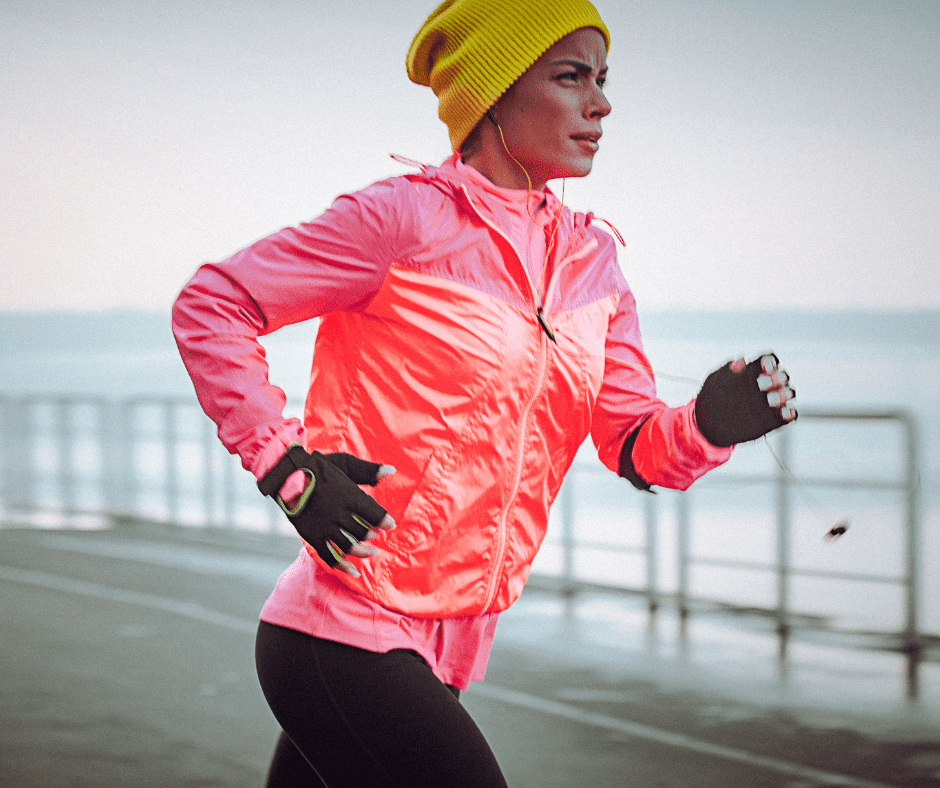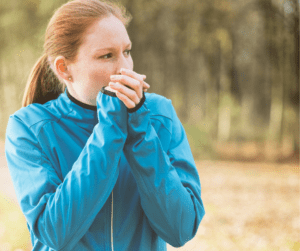As youngsters, our parents told us to button up in the winter and not run outside without our winter jackets on so that we can avoid catching that dreaded cold.
Well… Sorry parents… You were wrong.
The concept of catching a cold from the cold has been thoroughly studied and disproven countless times.
Think about it… the cold isn’t a virus or bacterium. So, why do we think it can infect us? And, what does this all have to do with you as a runner?
Well…
Running in winter is completely healthy and super good for you!
On that note, let’s have a look at why you won’t get sick from the cold, why it sometimes hurts when you breathe in the cold, how to protect yourself from the cold while running and some hacks for tackling running in winter…

Can You Get Sick From Running In The Cold?
No evidence proves that running in the cold harms the immune system. Getting outside in the cold weather can stimulate your immune system. The real threat is not dressing properly.
You’re probably thinking to yourself… then why does cold and flu season align with winter?
In winter months, more people huddle indoors and close windows to keep warm, so all the people in that shared space are exposed to whatever pathogens they are carrying.
Also, during winter in a lot of places, the air tends to be drier and that dry air will facilitate the transmission of viruses.
Is It OK To Run In The Cold?
Running in winter is not unhealthy at all as long as it’s done safely.
Pros Of Running In The Cold:
- Cooler weather… not necessarily cold is the ideal weather for running. The colder the weather, the less heat stress on your body, which makes it easier to run.
If temps are below 11 or 12 degrees then that is not ideal for running as the body spends a lot of energy to keep warm too.
Not that it’s bad for running, ideal running temperatures for best performance are between 12 – 16 degrees, this of course varies according to some other environmental factors too.
- Running outdoors in cooler weather can help you stay consistently active. Think about it, running inside on a treadmill or running outside in nature… Which one sounds more fun to you?
Although, when it comes to running in the cold, a good amount of people would rather run on a treadmill and be warm than outside in the cold. - When the days get shorter and the temperatures drop… many people suffer from Seasonal Affect Disorder. This normally occurs in climates where there is less sunlight at certain times of the year. Running helps release powerful hormones that help combat this depression, increasing your positive mood.
As hard as it is to get out when you feel like this. It may help you feel better.

Cons Of Running In The Cold:
- The cold air can hurt your lungs because it’s typically very dry, which can lead to coughing and shortness of breath. If you have asthma or similar conditions, the cold air can make them worse.
- Black ice can form on roads and pathways. It is quite hard to see especially when running in dim light so there is the risk of slipping and falling.
- Late sunrises and early sunsets mean runs in the dark. Not being easily visible is a risk for runners as well as not being able to see obstacles on the path clearly due to darkness.
- ITS COLD -, which means if you don’t have the right gear it’s not fun.
Why Does Running In The Cold Make Me Cough?
Cold, dry air can make you cough during or after your running session due to either bronchospasm, which is when the tubes that bring air in and out of your lungs constrict, or asthma.
Exercise asthma or exercise-associated bronchospasm:
When you reach high respiratory rates in the cold, you can develop contractions or spasms in the smooth muscle that surrounds your airways and also produce extra mucous in the lining of the lung tubes that result in your coughing.

How To Prevent Coughing While Running In The Cold
A cold-induced cough can be stopped by wearing a scarf or buff over your mouth and nose to prewarm and humidify the cold air.
An exercise-induced cough may be a marker for asthma since both dry air and cold air are triggers for asthma attacks.
If you often cough after cold runs, it’s important to meet a doctor just to determine if you have underlying asthma.
The Impact Of Heat, Cold, Humidity & Altitude On Your Running Performance
How To Breath In Cold Weather While Running
- Use a bandana, buff, or scarf to warm up the air you breathe in.
- Breathe in your nose and out your mouth. The air has to travel a greater distance to reach your lungs. Along the way, your nasal passages and trachea warm the cold air.
- Avoid high-intensity training in very cold weather as this could irritate your airways further, making it hard to breathe.
Do You Burn More Calories Running In The Cold?
Sure, a decent amount of research shows that shivering to keep your body warm does cause you to burn calories but… exercise raises the body’s temperature on its own without needing to expend more energy to do this.
In hot weather, it takes more cardiovascular effort to cool the body down. Therefore, exercising in warm weather would use more energy than exercising in the cold.
Tips For Running In The Cold
- Set a Goal
To get yourself out of your warm, cozy bed to go out and run in the cold, you need a BIG motivator.
Setting an achievable goal that excites you is going to help you do just that.

- Layer Up!
The key to dressing for a run in the cold is to dress in layers and breathable insulation – Gear made from insulating materials traps air, which is then warmed by your body heat. Air doesn’t conduct heat well, so trapped air retains warmth and keeps you warm.
The layers need to consist of:
a) A base layer that is close to your skin and should be made of a material that keeps moisture away from your skin.
b) A second layer that provides breathable insulation.
c) A weatherproof breathable outer layer to protect you from wind, rain, and snow.
Other clothing items include snow gear, traction shoes, etc… Gloves and a beanie are also key.
Also, gear for wet cold conditions will differ from just cold conditions.
- Warm Up Inside
It may seem obvious but warming up indoors really will work. Do drills and dynamic stretches before you step outside and don’t allow your body to cool down.
(You can grab our free running drills flow by clicking here)
- Slow Down
If you’re running in temperatures where there is a real risk of slipping on ice then slow down. Winter is a great time to build your aerobic base with easy slow running.
- Take Extra Caution In The Dark
Running in the dark brings with it lots of risks.
How To Run In The Dark Safely:
- Take your cellphone with you in case of emergencies, that is if you live in an area that is safe to run with your phone on you.
- Tell family when and where you may be running.
- Wear reflective running gear.
- Take it slow to avoid slipping/tripping.
- Run with friends if possible.
- Invest in a good running headlight.




Comments are closed.